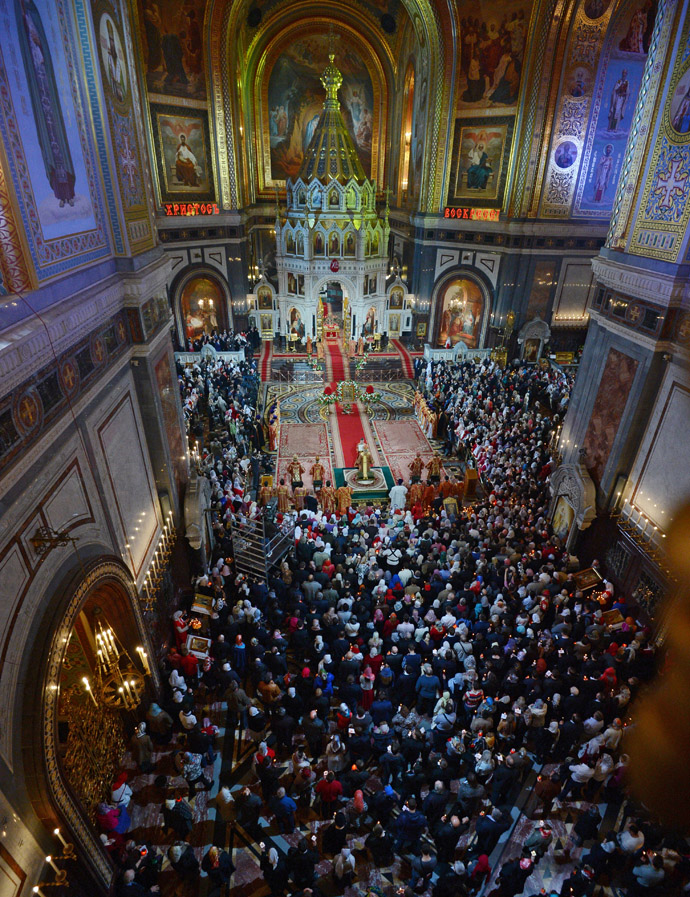Over 300,000 people have visited Moscow’s churches and monasteries over the Easter weekend in Russia. Police patrols were on alert to prevent breaches of peace and crime, with over 6,000 officers deployed to guard the city’s monasteries and churches.
Easter is the red letter day in the Orthodox calendar. The holy day is being celebrated by believers worldwide, with large-scale festivities to be held in Russia on Sunday.
Easter services are also organized at all Russian Orthodox churches across the world, the number of which exceeds 30,000.
But the largest service, helmed by Patriarch Kirill, is being held at the Cathedral of Christ the Savior. The service lasts several hours, well into the early hours of Sunday.
A group of pilgrims have also delivered the Holy Fire from the Old City of Jerusalem to the Russian Cathedral of Christ the Savior. It is lit each year at the Church of the Holy Sepulcher in Jerusalem on the day preceding Orthodox Easter. Tens of thousands of pilgrims visited Jerusalem on Saturday to observe the ‘Holy Fire’ ceremony.

Easter service at Christ the Savior Cathedral in Moscow. (RIA Novosti/Vladimir Astapkovich)
The Holy Fire has been perceived by generations of Orthodox believers as a miracle. It’s through divine intervention that the first flame comes to life, the faithful believe. Pilgrims say it doesn’t burn in the first minutes after it has been lit. Parts of the Holy Fire are ‘spread out’ between churches across the country, placed in torches akin to those used to transport the Olympic Flame.
After parishioners lit the candles from the Holy Fire, Kirill started the procession around the cathedral, glorifying the Resurrection. Priests and believers carrying crosses and icons get going around the church. The procession climaxed when the Patriarch announced “Christ is risen!”, meaning the Holy Day has started.

Worshippers at the Easter service at Christ the Savior Cathedral in Moscow. (RIA Novosti/Mikhail Mokrushin)
After midnight and for the next 40 days after Easter Sunday, Orthodox Christians will be greeting each other with the words "Christ is risen!" expecting the reply "He is risen indeed!" The end of the short dialogue is celebrated by three traditional kisses.
The festivities at the Christ the Savior Cathedral where attended by President Vladimir Putin, Prime Minister Dmitry Medvedev, and Moscow Mayor Sergey Sobyanin.

Members of the Svyato-Anfimovskaya Orthodox community in the village of Poteryayevka in Altai Territory attend the festive Easter church service, 2012. (RIA Novosti / Alexandr Kryazhev)
Christians celebrate Easter to mark the resurrection of Jesus Christ on the third day after his crucifixion. The Resurrection of the Savior symbolizes his victory over sin and death.
Preparations for Easter celebrations begin on the last day of the Holy Week, known in Russia as Passion Week. On Holy Saturday believers come to churches to have their paschal cakes and eggs blessed by priests.

Easter cakes consecrated in Russia. (RIA Novosti / Denis Gukov)
Easter is preceded by a long period of fasting. Believers abstain from meat, fish, eggs and dairy products for 48 days, spending time in prayer.
The real challenge is to help people refine their souls and learn to restrain desire.
Russians celebrate the end of Lent by painting colorful eggs – as a rule red, as a symbol of the blood of Christ - they exchange with each other, and preparing rich Easter cakes with raisins and nuts.
Easter is a moveable feast. Eastern and Western Christianity base their calculations on different calendars. The former uses Julian calendar, the latter Gregorian, so their Easter days differ.
Last year it was marked by the Eastern Orthodox, Catholic, Protestant and Anglican churches on the same day, which happens quite rarely.
In 2012 nearly half a million Muscovites flocked to the country's churches to take part in evening and night services across the Russian capital. The largest service drew 6,000 people and was held at the Cathedral of Christ the Savior. Patriarch Kirill, who heads the Russian Orthodox Church, led the Easter service in Moscow's landmark Cathedral.
The real challenge is to help people refine their souls and learn to restrain desire.
Russians celebrate the end of Lent by painting colorful eggs – as a rule red, as a symbol of the blood of Christ - they exchange with each other, and preparing rich Easter cakes with raisins and nuts.
Easter is a moveable feast. Eastern and Western Christianity base their calculations on different calendars. The former uses Julian calendar, the latter Gregorian, so their Easter days differ.
Last year it was marked by the Eastern Orthodox, Catholic, Protestant and Anglican churches on the same day, which happens quite rarely.
In 2012 nearly half a million Muscovites flocked to the country's churches to take part in evening and night services across the Russian capital. The largest service drew 6,000 people and was held at the Cathedral of Christ the Savior. Patriarch Kirill, who heads the Russian Orthodox Church, led the Easter service in Moscow's landmark Cathedral.

Easter cake. (RIA Novosti / Vladimir Fedorenko)

No comments:
Post a Comment
yes